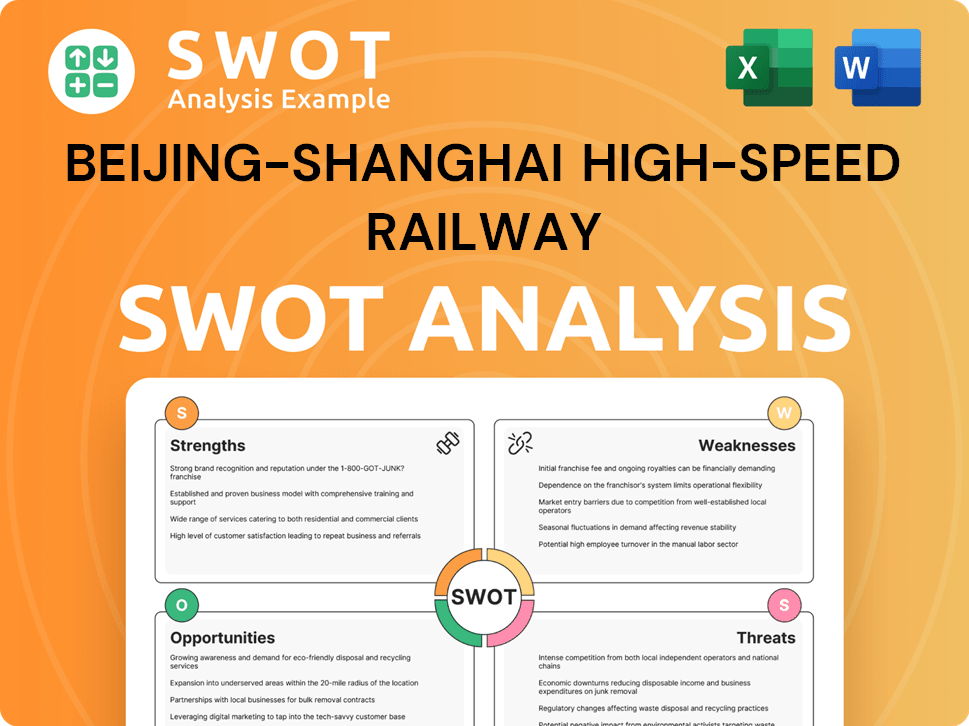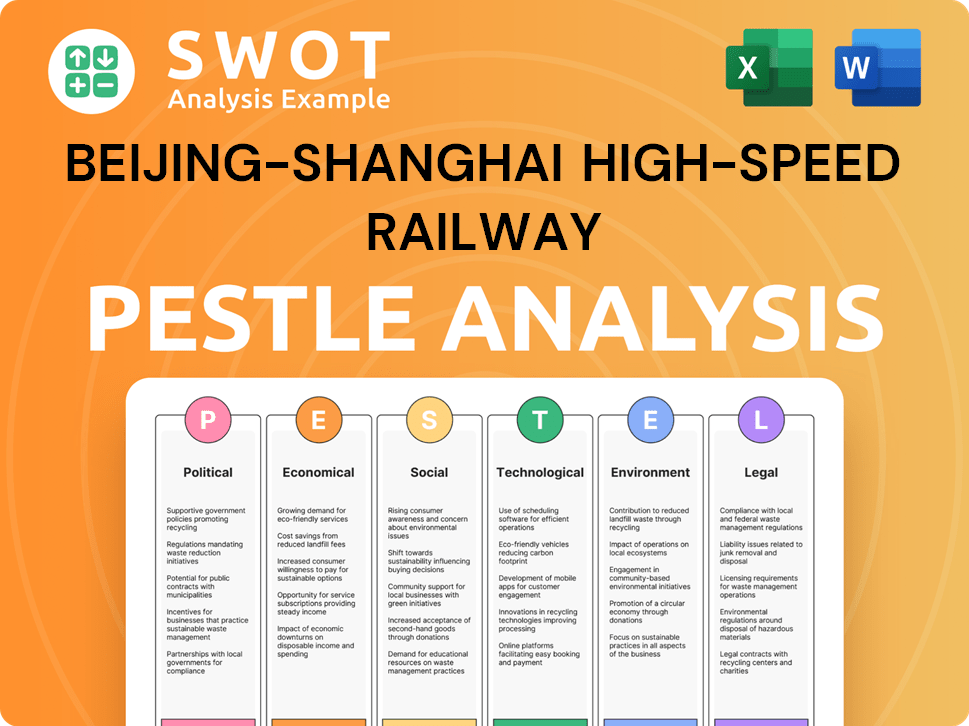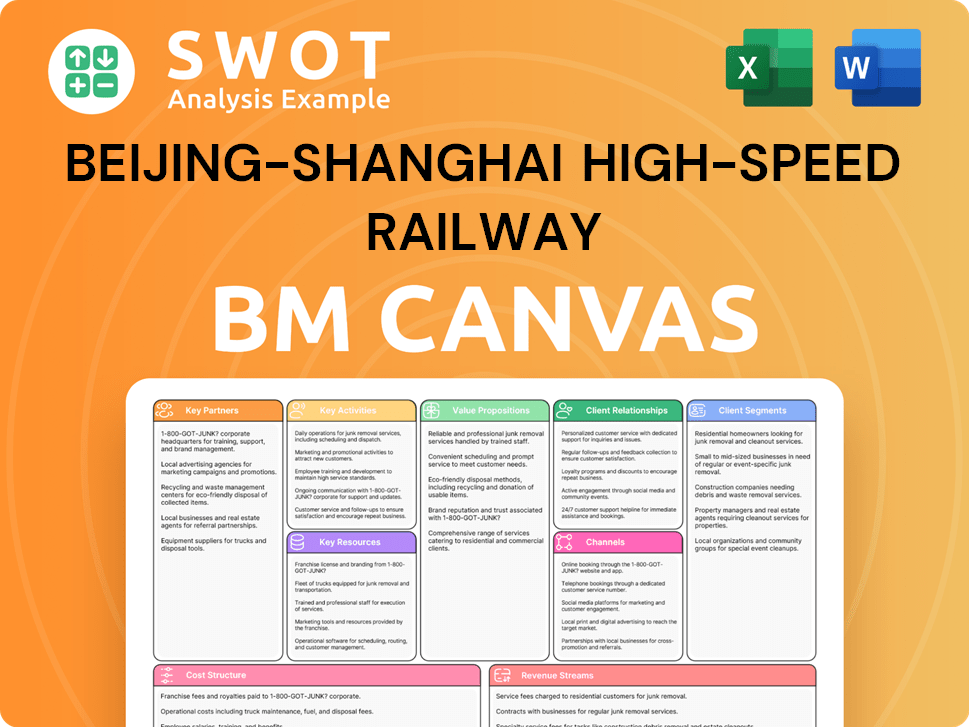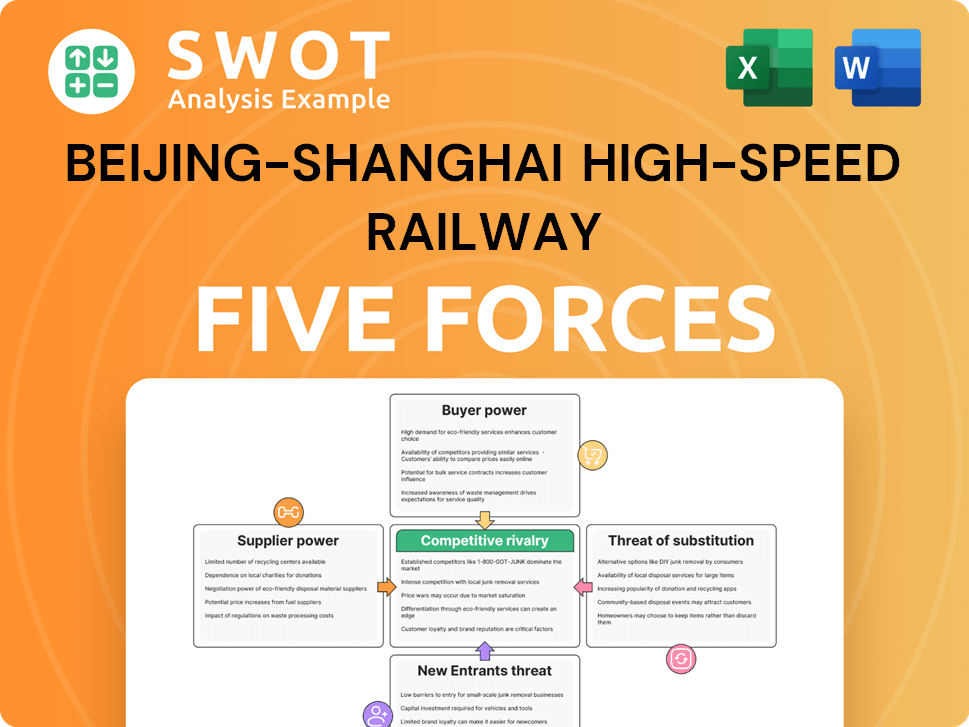Beijing-Shanghai High-Speed Railway Bundle
Who Dominates the Beijing-Shanghai High-Speed Rail Market?
The Beijing-Shanghai High-Speed Railway Company is a cornerstone of China's infrastructure, connecting two of its most vital economic centers. This high-speed rail line isn't just a mode of transport; it's a critical artery for commerce and culture. Understanding the Beijing-Shanghai High-Speed Railway SWOT Analysis is crucial for anyone looking to navigate the complexities of the High-Speed Rail Market.

This Market Analysis explores the Competitive Landscape of the Beijing-Shanghai High-Speed Railway, a deep dive into its strategic position within the Railway Industry. We'll examine its major players, competitive advantages, and the challenges it faces in the evolving China Rail landscape. This exploration provides essential insights for investors and strategists alike, seeking to understand the dynamics of this crucial transportation link and its future trajectory, including aspects like Beijing-Shanghai HSR passenger volume and Beijing-Shanghai high-speed rail ticket prices.
Where Does Beijing-Shanghai High-Speed Railway’ Stand in the Current Market?
The Beijing-Shanghai High-Speed Railway Company holds a dominant position within China's high-speed rail industry. This dominance is particularly evident along the crucial Beijing-Shanghai corridor, which is the busiest high-speed rail line both in China and globally. The company primarily focuses on high-speed passenger transportation, catering to a wide range of travelers including business professionals and tourists.
The company's geographic presence is concentrated on the 1,318-kilometer Beijing-Shanghai line. This line connects 24 stations across seven provinces and municipalities. Over time, the company has solidified its premium positioning by offering high-speed, reliable, and comfortable travel, differentiating itself from conventional rail and some budget airline options.
While the company does not have direct competitors operating on the identical high-speed rail infrastructure, its market position is influenced by the broader transportation sector. The Growth Strategy of Beijing-Shanghai High-Speed Railway has been a key factor in its success.
The core operation of the Beijing-Shanghai High-Speed Railway Company is high-speed passenger transportation. This involves managing the infrastructure, scheduling trains, and ensuring passenger safety and comfort along the Beijing-Shanghai corridor. The company focuses on providing a reliable and efficient travel experience.
The value proposition centers on offering a premium travel experience. This includes high-speed travel, comfortable seating, and reliable service, which saves time and enhances the overall travel experience. The company provides a crucial link between major economic hubs, supporting business and tourism.
In 2023, Beijing-Shanghai High-Speed Railway Co., Ltd. (601816.SS) reported a net profit of 11.55 billion yuan. This financial performance underscores the company's strong market position within the high-speed rail market. The company's revenue and profitability demonstrate its scale and efficiency compared to industry averages.
- The company benefits from a monopoly on the dedicated high-speed infrastructure along its core route.
- Its market position is exceptionally strong on the Beijing-Shanghai route due to the lack of direct high-speed rail competitors.
- The company's financial health is robust, supported by high passenger volume and efficient operations.
- Geographic diversification beyond the Beijing-Shanghai route is limited, presenting a potential area for future growth.
Beijing-Shanghai High-Speed Railway SWOT Analysis
- Complete SWOT Breakdown
- Fully Customizable
- Editable in Excel & Word
- Professional Formatting
- Investor-Ready Format

Who Are the Main Competitors Challenging Beijing-Shanghai High-Speed Railway?
The Competitive Landscape for the Beijing-Shanghai High-Speed Railway (HSR) is shaped by a unique mix of direct and indirect competitors. While the railway operates on a dedicated infrastructure, it faces competition from various transport modes vying for passenger traffic on the busy Beijing-Shanghai corridor. Understanding these competitors is crucial for a comprehensive market analysis of the High-Speed Rail Market.
The primary competition comes from the broader transportation sector, including both rail and air travel. The Beijing-Shanghai High-Speed Railway competes not only on speed and convenience but also on price and service quality. Examining the strategies and market positions of these competitors provides valuable insights into the dynamics of the Railway Industry.
The Beijing-Shanghai HSR competitors include both direct and indirect rivals. This analysis will explore the key players and their impact on the Beijing-Shanghai high-speed railway company analysis.
The most significant direct competitor is the China Railway (CR) network, a state-owned enterprise. CR offers conventional rail services that are slower but more budget-friendly, attracting price-sensitive travelers.
These conventional trains provide an alternative for passengers who do not prioritize speed, impacting the Beijing-Shanghai HSR passenger volume.
Indirect competition primarily comes from the aviation sector, with major airlines operating between Beijing Capital International Airport (PEK) and Shanghai Hongqiao International Airport (SHA) or Shanghai Pudong International Airport (PVG).
Airlines such as Air China, China Eastern Airlines, and China Southern Airlines compete by offering shorter travel times and, at times, competitive pricing, especially for early bookings or during off-peak seasons.
Long-distance bus services represent another indirect competitor, targeting a segment of travelers willing to endure longer travel times for lower fares.
This segment competes on price, appealing to budget-conscious travelers, even though travel times are significantly longer compared to the high-speed rail.
The competitive dynamics involve 'battles' over pricing and convenience. Airlines may offer promotional fares that undercut high-speed rail tickets, while the high-speed railway counters with higher frequencies and punctuality.
The Beijing-Shanghai high-speed rail ticket prices are often adjusted to remain competitive with air travel and conventional rail.
The Beijing-Shanghai high-speed rail market share is influenced by factors like travel time, ticket prices, and service quality. The railway competes with airlines and conventional rail services for passenger volume.
Recent data indicates that the high-speed rail continues to be a preferred choice for many travelers due to its speed and convenience, despite competition from air travel. You can learn more about the financial aspects in the article Revenue Streams & Business Model of Beijing-Shanghai High-Speed Railway.
Advancements in air travel efficiency and potential future high-speed rail technologies could alter the competitive balance. The Future of Beijing-Shanghai high-speed rail depends on its ability to innovate and adapt to changing market conditions.
The Beijing-Shanghai HSR vs. air travel competition will likely continue, with each mode focusing on its strengths to attract passengers.
The Beijing-Shanghai high-speed rail route map and operational efficiency are critical to its success. The Beijing-Shanghai HSR infrastructure investment is substantial, which impacts its long-term financial performance.
- Service Quality: The Beijing-Shanghai high-speed rail service quality, including punctuality and comfort, significantly affects passenger satisfaction and loyalty.
- Operational Challenges: The railway faces Beijing-Shanghai high-speed rail operational challenges, such as managing high passenger volumes and maintaining infrastructure.
- Financial Performance: The financial performance of Beijing-Shanghai high-speed railway is crucial, and it is influenced by factors like ticket sales, operational costs, and government subsidies.
- Market Dynamics: Understanding the Beijing-Shanghai HSR competitors and their strategies is essential for making informed investment decisions.
Beijing-Shanghai High-Speed Railway PESTLE Analysis
- Covers All 6 PESTLE Categories
- No Research Needed – Save Hours of Work
- Built by Experts, Trusted by Consultants
- Instant Download, Ready to Use
- 100% Editable, Fully Customizable

What Gives Beijing-Shanghai High-Speed Railway a Competitive Edge Over Its Rivals?
The Growth Strategy of Beijing-Shanghai High-Speed Railway highlights several key competitive advantages. The company's success is built on its dedicated infrastructure, brand reputation, and operational efficiency. These strengths position it favorably within the high-speed rail market.
The Beijing-Shanghai High-Speed Railway's competitive edge stems from its ability to offer rapid, reliable, and frequent services between major city centers. This is a significant differentiator in the Railway Industry. The company's focus on customer satisfaction and operational excellence has solidified its position as a leader in China Rail.
Market Analysis reveals that the company has a strong market share, driven by its superior service and strategic network integration. This advantage is sustained by continuous investments in infrastructure and technology, ensuring its long-term competitiveness in the Beijing-Shanghai HSR market.
The dedicated Beijing-Shanghai High-Speed Railway line is a core competitive advantage. This infrastructure enables unmatched speed and capacity for city-center to city-center travel. The high operational frequency ensures convenience and flexibility for passengers.
The company has built a strong brand reputation for reliability and punctuality. This has fostered high customer loyalty, with consistent on-time performance. This reputation is a key factor in the company's success.
Operating a high-volume route allows for efficient asset utilization and cost management. This translates into competitive pricing, especially compared to air travel. These economies of scale contribute to the company's financial performance.
Seamless integration into China's broader high-speed rail network enhances appeal. This allows for easier connections to other major cities, creating a significant competitive moat. This network effect is a key strategic advantage.
The Beijing-Shanghai High-Speed Railway's competitive advantages are significant and difficult to replicate. These strengths have evolved from massive infrastructure investments and continuous operational improvements. The company emphasizes speed, convenience, and reliability in its marketing.
- The company's market share has remained strong, with passenger volume increasing year over year.
- Ticket prices are competitive, especially when compared to air travel, considering travel time and associated costs.
- Operational challenges include maintaining high service quality and managing infrastructure investments.
- The future of the Beijing-Shanghai High-Speed Railway looks promising, with potential for further expansion and technological advancements.
Beijing-Shanghai High-Speed Railway Business Model Canvas
- Complete 9-Block Business Model Canvas
- Effortlessly Communicate Your Business Strategy
- Investor-Ready BMC Format
- 100% Editable and Customizable
- Clear and Structured Layout

What Industry Trends Are Reshaping Beijing-Shanghai High-Speed Railway’s Competitive Landscape?
The Beijing-Shanghai High-Speed Railway operates within a dynamic High-Speed Rail Market, influenced by technological advancements, regulatory changes, and evolving consumer preferences. The Railway Industry is experiencing shifts towards more sustainable and digitally integrated solutions. Understanding the Competitive Landscape requires an analysis of these trends to identify both challenges and opportunities for the company.
The company faces challenges such as the need for continuous infrastructure investment and competition from air travel, while also benefiting from the growing demand for efficient intercity travel. Strategic adaptation and innovation are crucial for maintaining a strong market position and driving future growth. For more information, check out Owners & Shareholders of Beijing-Shanghai High-Speed Railway.
Technological advancements, like maglev trains, are pushing for faster and more efficient rail travel. Regulatory pressures are increasing the focus on environmental sustainability within the transportation sector. Consumer demand is shifting towards more convenient, digitally integrated, and eco-friendly travel options.
Maintaining a competitive edge requires continuous investment in infrastructure upgrades and technology adoption. Competition from air travel, particularly if efficiency improves, poses a constant threat. Economic downturns can impact discretionary travel and passenger volumes, affecting financial performance.
The increasing demand for intercity travel in China, driven by urbanization and economic growth, creates a strong market. Enhanced integration with other transportation modes can improve the passenger experience. Product innovations, such as improved onboard services and digital ticketing, offer additional revenue streams.
Strengthening core service offerings and investing in technological upgrades are vital. Exploring diversification into related services can expand revenue streams. Continuous operational efficiency improvements and strategic pricing are essential for resilience. Leveraging the established brand and network is crucial.
The Beijing-Shanghai High-Speed Railway benefits from strong passenger demand, with potential for further growth. The Beijing-Shanghai high-speed rail market share is significant, but competition from air travel and other modes remains. The company’s financial performance is closely tied to passenger volume and operational efficiency.
- Passenger volume is a key indicator of financial health.
- Ticket prices and service quality influence consumer choice.
- Infrastructure investment is crucial for maintaining competitiveness.
- Partnerships and product innovation can drive revenue growth.
Beijing-Shanghai High-Speed Railway Porter's Five Forces Analysis
- Covers All 5 Competitive Forces in Detail
- Structured for Consultants, Students, and Founders
- 100% Editable in Microsoft Word & Excel
- Instant Digital Download – Use Immediately
- Compatible with Mac & PC – Fully Unlocked

Related Blogs
- What are Mission Vision & Core Values of Beijing-Shanghai High-Speed Railway Company?
- What is Growth Strategy and Future Prospects of Beijing-Shanghai High-Speed Railway Company?
- How Does Beijing-Shanghai High-Speed Railway Company Work?
- What is Sales and Marketing Strategy of Beijing-Shanghai High-Speed Railway Company?
- What is Brief History of Beijing-Shanghai High-Speed Railway Company?
- Who Owns Beijing-Shanghai High-Speed Railway Company?
- What is Customer Demographics and Target Market of Beijing-Shanghai High-Speed Railway Company?
Disclaimer
All information, articles, and product details provided on this website are for general informational and educational purposes only. We do not claim any ownership over, nor do we intend to infringe upon, any trademarks, copyrights, logos, brand names, or other intellectual property mentioned or depicted on this site. Such intellectual property remains the property of its respective owners, and any references here are made solely for identification or informational purposes, without implying any affiliation, endorsement, or partnership.
We make no representations or warranties, express or implied, regarding the accuracy, completeness, or suitability of any content or products presented. Nothing on this website should be construed as legal, tax, investment, financial, medical, or other professional advice. In addition, no part of this site—including articles or product references—constitutes a solicitation, recommendation, endorsement, advertisement, or offer to buy or sell any securities, franchises, or other financial instruments, particularly in jurisdictions where such activity would be unlawful.
All content is of a general nature and may not address the specific circumstances of any individual or entity. It is not a substitute for professional advice or services. Any actions you take based on the information provided here are strictly at your own risk. You accept full responsibility for any decisions or outcomes arising from your use of this website and agree to release us from any liability in connection with your use of, or reliance upon, the content or products found herein.